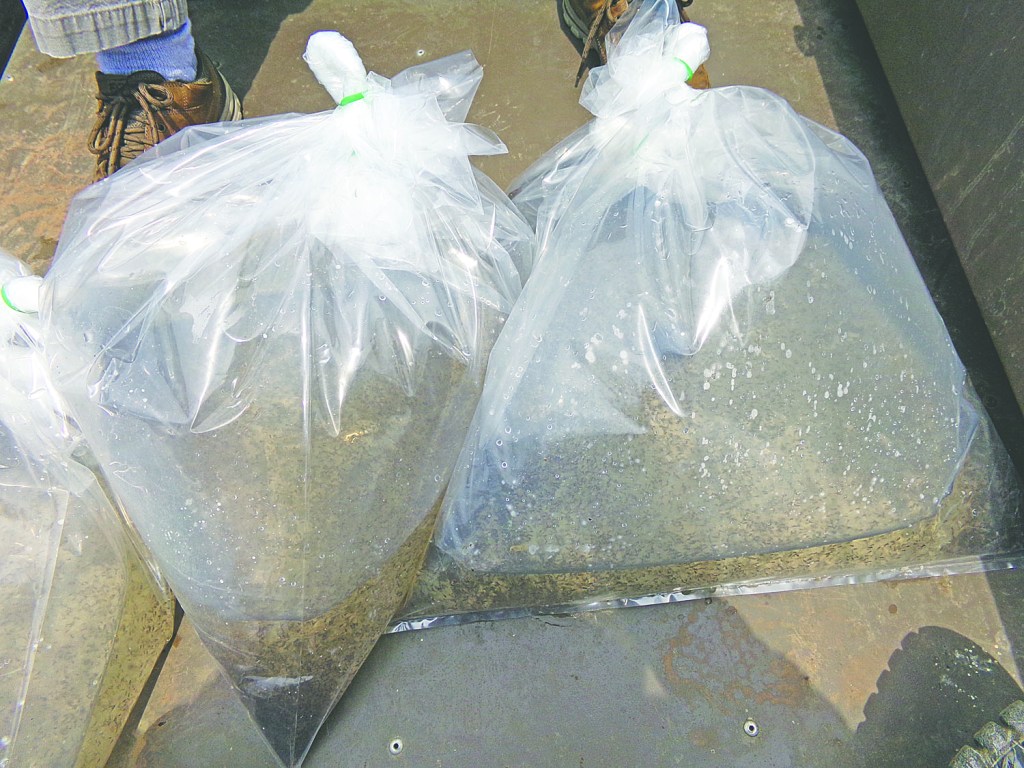Biologists release 1.8M Fla. bass fry
Published 1:30 am Sunday, April 21, 2019

- Florida bass fry, 25,000 per bag, look like specks of dirt moving in the water as they wait to be stocked Wednesday into Sandy Cove on Lake Fausse Pointe.
COTEAU HOLMES – Hundreds of thousands of Florida bass fry — so small they appeared to be specks of dirt moving around in specially prepared bags — were released Wednesday afternoon in Lake Dauterive-Fausse Pointe by the state Department of Wildlife and Fisheries.
If 7 percent, the high end of a state biologist’s projected mortality rate, of those 1.8 million fry survive as fingerlings and juveniles, then grow to be adults, 126,000 Florida bass will be in the local lake system‘s fishery.
Jody David, District 6 Inland Fisheries biologist manager for the LDWF, and Brad Launey, District 6 biologist supervisor, met one of two hatchery trucks from Booker Fowler Fish Hatchery near Forest Hill at midday Wednesday at Lake Fausse Pointe State Park.
Twelve large plastic bags were unloaded from big ice chests inside the hatchery truck that traveled to Lake Fausse Pointe State Park. Each of those bags transferred to the department’s boat held 25,000 Florida bass fry, according to David.
David and Launey released 200,000 of those tiny bass in Sandy Cove, a natural spawning environment over the years for bass and an area that is pressured heavily by bass anglers each spring. The other 100,000 Florida bass fry were released in Coon Slough, another traditional spawning area.
The state hatchery truck also carried 340,800 Florida bass fry in its two large tanks and those fish were released at the state park’s boat landing before Launey and David cranked up the 36-h.p. Pro-Drive and drove to Sandy Cove.
“We’ve got to go and get them in the water soon,” David said, noting each bag was double-bagged and oxygen inserted to keep the fry healthy for the trip.
Another hatchery truck carrying a little more than 800,000 Florida bass fry from the state hatchery for the lake system released those fish at two boat landings in Lake Dauterive, David said. Its arrival was expected later that afternoon after other stops, he said.
Booker Fowler Fish Hatchery, the state agency’s primary fish production facility that began producing freshwater sportfish in the spring of 1997, had an excess of Florida bass fry. Those bass fry are moved to special lined outdoor ponds on the grounds, where they feed and grow to finger size and then are released into the wild.
“The hatchery did real well this spring,” he said about the spawn, noting the state hatchery triggered it on Valentine’s Day.
Booker Fowler Fish Hatchery did so well with the spawn that after the eggs hatched the ¼- and ½-acre rearing ponds couldn’t handle all the Florida bass fry. A call went out to state biologists across the state to determine which bodies of water they would want to stock the tiny bass.
David chose Lake Dauterive-Fausse Pointe.
“These are being distributed throughout the state now. That’s how we got them,” David said about the nearly 2 million Florida bass fry earmarked for Lake Dauterive-Fausse Pointe.
The fish were delivered here by Chris Yancey of Glenmora, a technician at Booker Fowler Fish Hatchery.
How small were those fish released Wednesday afternoon in parts of Lake Dauterive and Lake Fausse Pointe? Really, really, really tiny, considering it takes 300 Florida bass fry to make a gram (300 fry/g), according to state biologists at the Booker Fowler Fish Hatchery. It takes 453.59237 grams to make a pound.
“They’re small,” David said in an understatement.
A Texas Parks and Wildlife Department study for April 2011 found that 7-day-old Florida bass fry are 7.27 mm long, equal to 0.286220 inches.
For sure, David said, the mortality rate will be high. They stay together for a while, he said, which is their way of protecting themselves. Also, they are released in and around aquatic vegetation, which offers them cover for predators.
What percentage of those 1.8 million Florida bass fry will survive after being stocked in the lake system? That’s a million dollar question or, as David put it, a magical question.
“Three to 5 to 7 percent would be good. That’s an assumption,” he said.
“Now we’ve got to wait and let them grow out,” the state biologist said.
How long will that be?
After one year, depending on the available forage and available habitat, those specks could be 6 to 8 inches long, David said. After two years, the fish generally are 12 to 14 inches long, he said.





